Accepted Scientific Name: Euphorbia resinifera O.Berg in O.Berg & C.F.Schmidt
Darstell. Beschr. Offiz. Gew. 4: 34d verso. (1863). O.Berg & C.F.Schmidt
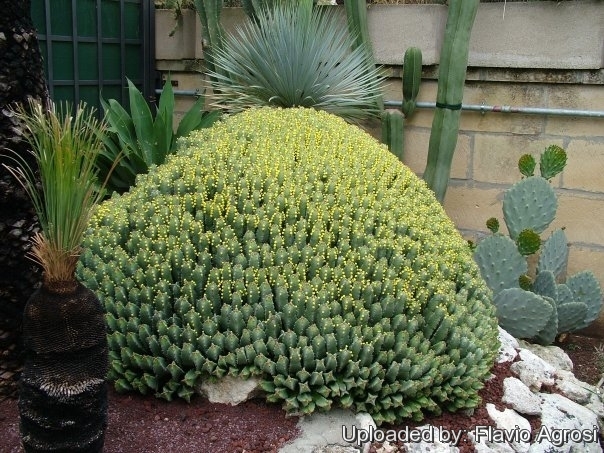
Tithymalus resiniferus (Euphorbia resinifera) Photo by: Flavio Agrosi
Origin and Habitat: It is native to Morocco, where it occurs on the slopes of the Atlas Mountains in the surroundings of Marrakesh.
Synonyms:
See all synonyms of Euphorbia resinifera
Common Names include:
ENGLISH: Resin Spurge, Moroccan Mound, Moroccan Mound Spurge, Moroccan Ground Spurge, Officinal Spurge, Spurge, Poisonous Gum-Thistle, Farbiyun, Euphorbium, Euphorbe, Euforbium, African Spurge, Gum euphorbia
ARABIC ( لعربية ): طيكجوت Tikjout (Maroc - Morocco), لبانة مغربية (Lubānā maghrabīyā)
DANISH (Dansk): Marokkansk euforbie
FRENCH (Français): Euphorbe résinifère, Euphorbe mellifère, Euphorbe du maroc, Euphorbe du Maghreb, Euphorbe cactiforme à quatre côtes
GERMAN (Deutsch): Harz-Wolfsmilch
GREEK (Ελληνικά): ευφορβία η ρητινοφόρος
ITALIAN (Italiano): Euforbia resinifera
LITHUANIAN (Lietuvių): Kaučiukinė karpažolė
PORTUGUESE (Português): Mama-leite, Maleiteira
RUSSIAN (Русский): Молочай смолоносный (Molochai smolonosnyj)
SWEDISH (Svenska): Prustkåda
Description: Euphorbia resiniferaSN|16003]]SN|16003]] is a dense succulent shrub growing to 60 cm tall, forming multi-stemmed cushion-shaped clumps up to 2 m wide.
Stems: Erect, succulent, 4 sided (almost square) that look superficially like a cactus. Light green to glaucous blue color, depending upon light.
Spines: Brown and short, but sharp in pairs of 6 mm spines on the angles of the ribs, spaced about 1 cm apart up the stem.
Subspecies, varieties, forms and cultivars of plants belonging to the Euphorbia resinifera group
Notes: This is probably the oldest known succulent plant of all, having been discovered by an eastern king about 25BC, and may have been the plant which was originally named Euphorbia.
Bibliography: Major references and further lectures.
1) Urs Eggli “Illustrated Handbook of Succulent Plants: Dicotyledons” Springer Science & Business Media, 2002
2) Hermann Jacobsen “Abromeitiella to Euphorbia” Blandford Press, 1960
 Tithymalus resiniferus (Euphorbia resinifera) Photo by: Valentino Vallicelli
Tithymalus resiniferus (Euphorbia resinifera) Photo by: Valentino Vallicelli Tithymalus resiniferus (Euphorbia resinifera) Photo by: Flavio Agrosi
Tithymalus resiniferus (Euphorbia resinifera) Photo by: Flavio Agrosi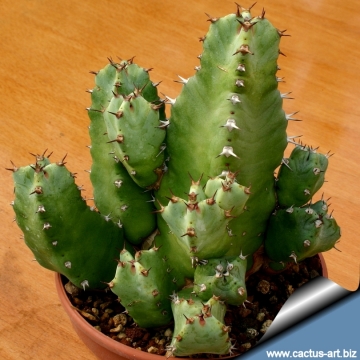 Tithymalus resiniferus (Euphorbia resinifera) Photo by: Cactus Art
Tithymalus resiniferus (Euphorbia resinifera) Photo by: Cactus Art Tithymalus resiniferus (Euphorbia resinifera) Photo by: Julio C. García
Tithymalus resiniferus (Euphorbia resinifera) Photo by: Julio C. García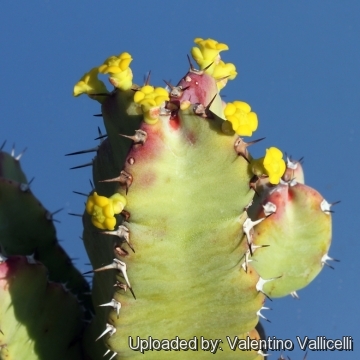 Tithymalus resiniferus (Euphorbia resinifera) Photo by: Valentino Vallicelli
Tithymalus resiniferus (Euphorbia resinifera) Photo by: Valentino Vallicelli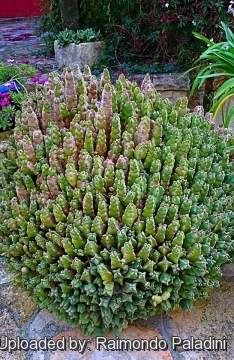 Tithymalus resiniferus (Euphorbia resinifera) Photo by: Raimondo Paladini
Tithymalus resiniferus (Euphorbia resinifera) Photo by: Raimondo Paladini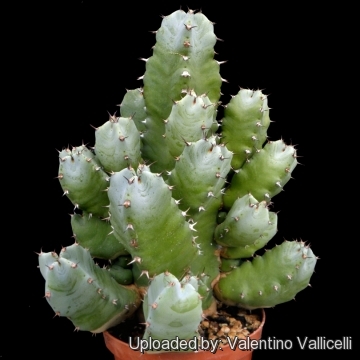 - This Euphorbia looks much like a cactus, although the two are not closely related, it is a small rapidly suckering plant that will form dense multi-stemmed cushion-shaped clumps up to 2 m wide. (Euphorbia resinifera) Photo by: Valentino Vallicelli
- This Euphorbia looks much like a cactus, although the two are not closely related, it is a small rapidly suckering plant that will form dense multi-stemmed cushion-shaped clumps up to 2 m wide. (Euphorbia resinifera) Photo by: Valentino Vallicelli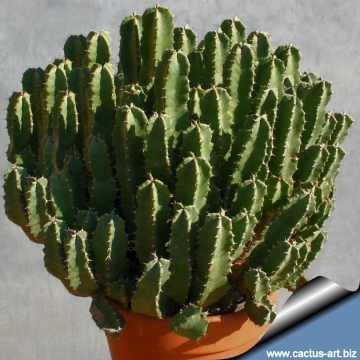 Tithymalus resiniferus (Euphorbia resinifera) Photo by: Cactus Art
Tithymalus resiniferus (Euphorbia resinifera) Photo by: Cactus ArtCultivation and Propagation: Commonly sold at garden outlet centres they are some of the easiest and care-free Euphorbias to grow, both in pots and in the ground in areas with a mild climate, but they can even be grown indoors. They grow well in a very draining mineral potting substrate, but they aren't picky about soil. During the summer they enjoy average feeding and watering. When dormant, plants are relatively cold tolerant. They will rapidly mound, branch and spread. These are widely adaptable, able to take full sun that helps the plants to keep their compact growth-form, but different clones vary in their tolerance of full sunshine
Warning: As with all other Euphorbias when a plant get damaged it exudes a thick white milky sap known as latex. This latex (resin) is poisonous contains some of the most potent irritants known. The very high irritant activity of the latex may be ascribed to resiniferatoxin (A potent toxin). The latex is particularly dangerous for the eyes, skin and mucous membranes. It can produce burning pain in bones. Pains in limbs and paralytic weakness in the joints. Important respiratory and skin symptoms, terrible burning pains. So pay extreme attention not to get any in your eyes or mouth. Cultivated plants must be handled carefully.
Your Photos
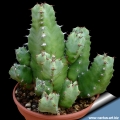
by Cactus Art
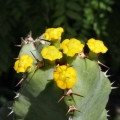
by Valentino Vallicelli





















